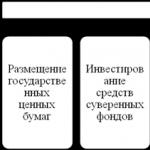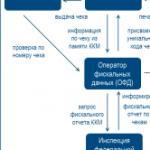Medication therapy. Drug therapy Quality control of drug therapy
It is customary to distinguish between the following types of drug therapy.
1. Symptomatic therapy - ie. aimed at eliminating certain
symptom of the disease, for example, the appointment of antitussives for
bronchitis.
2. Etiotropic therapy - elimination of the cause of the disease, when medicinal
substances destroy the causative agent of the disease. For example, the treatment of infectious
diseases with chemotherapeutic agents.
3. Pathogenetic therapy - aimed at eliminating the development mechanism
diseases. For example, using pain relievers for trauma when
pain syndrome leads to the development of a life-threatening shock.
4. Substitution therapy - restoration in the body of a deficiency of natural
substances formed in it (hormones, enzymes, vitamins) and taking
participation in the regulation of physiological functions. For example, the introduction of hormonal
drug in case of loss of function of the corresponding gland. Substitute
therapy, without eliminating the causes of the disease, can provide vital activity in
for years. So, insulin preparations do not affect the production of this
hormone in the pancreas, but with constant administration to the patient
diabetes mellitus provide a normal metabolism of carbohydrates in his body.
The body's reaction to medicinal substances. The body's cells respond to
the effect of various medicinal substances is very monotonous. Basically
changes in cell functions under the influence of drugs are reduced either to an increase
(excitement), or to a decrease (inhibition) of their activity. For example with
with the help of medicines, you can easily increase or decrease the secretion of gastric
glands and thus affect digestion. The action of some drugs
even if their concentration remains constant, it increases over time.
This may be due to their accumulation in the body (e.g. strychnine) or
summation of individual effects of action (for example, ethyl alcohol), When
repeated injections of the drug may increase sensitivity to it
organism - this phenomenon is called sensitization. Or vice versa
weaken - the body becomes accustomed to the re-introduction of some
medications (e.g. morphine, ephedrine).
Pal - differences in sensitivity to medicinal substances in individuals of different
the floor is small. In some cases, it has been experimentally established that women
are more sensitive than men to some poisons, for example, nicotine, but more
resistant to alcohol. But we must bear in mind that under special conditions,
inherent female body, its sensitivity to certain substances
may change: during menstruation, pregnancy, lactation.
Body weight - in some cases, for greater accuracy, the dosage of medicinal
substances are calculated per 1 kg of body weight.
Individual sensitivity - drug sensitivity
in humans fluctuates significantly. For some, it can be increased to a very
strong degree. In this case, they speak of idiosyncrasy, based on
modern concepts are congenital enzyme deficiency, manifested
allergic reaction (see below. Complications of drug treatment).
Age - children are susceptible to drug sensitivity
some hesitation. For example, children are more sensitive to morphine, strychnine,
less to atropine, quinine, cardiac glycosides. According to age
dosage medicines changes accordingly.
Special attention it is necessary to turn to poisonous and potent agents,
the therapeutic dose of which is calculated for adults (25 years). IN
youthful and childhood it is reduced approximately like this: at 18 years old - 3/4
doses for adults, at 14 years old - 1/2, at 7 years old - 1/3, at 6 years old - 1/4, at 4 years old
1/6, at 2 years - 1/8, at 1 year - 1/12, up to 1 year - 1/24 - 1/12 dose for
an adult. Higher doses are reduced to 3/4 and 1/2 also for persons over 60 years old.
The importance of nutrition - in many cases when using medicinal substances
a certain diet is necessary, for example, in the treatment of diabetes
insulin, attracting some poisoning, and so on.
The interaction of drugs with food should also be taken into account. It is impossible
drink tetracycline with milk or dairy products due to their content
a large amount of calcium, with the ions of which it interacts. At the same
time drugs such as acetylsalicylic acid, butadione, diphenin,
indomethacin, metronidazole, iron salts, steroids, furadonin are recommended
drink milk to reduce their irritating effect on the mucous membrane
alimentary canal. Calcium chloride, calcium gluconate easily form with acetic acid,
oxalic, carbonic and fatty acids hardly soluble complexes,
excreted in the feces. Therefore, such drugs are recommended to be taken over 40
minutes before meals, and one tablespoon of 10% calcium chloride solution is needed
dissolve in 1/3 cup of water to reduce its irritating effect on
gastric mucosa. Bile forms poorly soluble complexes with
antibiotics such as: polymyxin, neomycin, nystatin - take them
follows 30 minutes before meals. The same bile promotes absorption
fat-soluble medicinal substances. These are vitamins, hormones - they are taken
on the contrary, after eating.
Interaction of drugs. Very often with a particular disease
take not one, but two, or even more different drugs.
It is necessary to know the mechanism of their action. Medicinal substances can
act in one direction, and then the effect they have
is summed up. If the drugs taken work in the opposite
directions, such cases are designated as antagonism ("struggle" of effects). IN
medical practice, the simultaneous appointment of several drugs is
more and more use, since such a combined method leads to
strengthening therapeutic treatment or weakening and prevention of side
phenomena and complications. So, in the treatment of hypertension, they simultaneously use
cardiac vasodilator glycosides and diuretics, thus
acting in a complex manner on various links of a single circulatory system.
The drugs affect each other at any stage of their passage through the body:
absorption, transport phase, metabolism (intracellular metabolism),
excretion from the body.
It is not rational to use adsorbents (aluminum hydroxide, almagel, magnesium
sulfate) together with alkaloids, glycosides, enzyme preparations,
dyes, antibiotics. Physicochemical properties are not compatible in
one syringe of besilnenicillia with chloramphenicol, chlorpromazine, genarin,
tetracycline, B vitamins.
Routes of drug administration into the body.
To achieve a pharmacological effect, medicinal substances need
enter into the body or apply to its surface. Medicines are injected into
the body in different ways, and each method is different in its own
features. The following are of greatest practical importance.
1. Inside through the mouth (enteral) drugs are administered in the form
solutions, powders, tablets, capsules, pills. Oral administration is
in the simplest and most convenient way, however, there are some drawbacks, since
the absorption of the drug through the intestines into the blood is not accurate
quantitative accounting, some drugs are destroyed in the intestines, and
in the liver, and thus lose their activity. Therefore it is necessary
or water, etc.).
2. The use of drugs under the tongue (sublingual). The advantages of this method:
medicinal substances, without decomposing gastric juice, quickly enter
systemic blood flow, thereby ensuring the development of the desired effect.
Disadvantages: irritation of the oral mucosa.
3. Introduction into the rectum (rectal). Avoids annoying
action on the stomach, as well as use medications in cases where it is difficult
or we cannot take them by mouth (nausea, vomiting, spasm or obstruction
esophagus). The rectal is injected with suppositories and fluids using enemas.
4. Parenteral (outside the gastrointestinal tract) administration of drugs:
various options for injection, inhalation, electrophoresis and surface application
them on the skin and mucous membranes. a) Intravenous injections, intra-arterial,
intramuscular, subcutaneous. Advantages: fast onset of effect, accuracy
therapeutic dose, the possibility of introducing substances that are not absorbed from
gastrointestinal tract. Precautions: Do not administer medications until
there is no conviction that the needle is in the vein. Ingestion of a medicinal substance
the peri-venous space can cause severe irritation, up to
tissue necrosis. It can be dangerous if the needle accidentally hits other
blood vessels... Some drugs need to be injected slowly during
avoid severe complications... The injection is not performed near the nerve
trunks, damage to which can cause severe pain, sometimes muscle paresis.
b) Inhalation. Inhalation of medicinal substances in the form of aerosols, gases and
powders, are quickly absorbed and have local and general effects. in)
Superficial (external) application - ointments, lotions, powders, compresses, etc.
used to obtain a local effect. d) Electrophoresis. The method is based on
the use of galvanic current for the transfer and introduction of medicinal
substances from the surface of the skin into deep tissues.
From the body, medicinal substances and their decay products are excreted in the feces,
urine, excretion with air, sweat, saliva and lacrimal is less important
liquid.
Kidneys. Most medicinal substances are excreted by the kidneys regardless of
concentration in the blood by filtration in the glomeruli.
Digestive tract. In this way, as a rule, many alkaloids are released and
heavy metals.
Leather. Skin glands are able to secrete bromine, iodine, arsenic and some others
substances.
Airways. Gaseous and volatile compounds are released through them.
Milk glands. The ability to release medicinal substances by these glands
must be considered from two points of view. First, this can
use to inject drugs into the child's body, but, on the other hand
hand, the noted fact poses a danger of possible poisoning
breastfed baby.
The most common and simplest method of treatment for diseases is drug therapy. The doctor will prescribe medications using various routes of administration: it is important to strictly follow the recommendations of a specialist, without trying to change the therapy regimen on your own. Medicines can be part of a complex therapy used according to indications for different options traditional treatment diseases.
Tablets - simple and effective method treatment
Drug therapy - drug forms
The most common formulation for traditional therapy is tablets. The usual and frequently used drugs are always available in the home medicine cabinet. In addition to tablets, depending on the doctor's prescriptions, drug therapy involves the use of the following dosage forms:
- capsules;
- dragee;
- syrup;
- tincture;
- powders (sachets);
- candles (suppositories);
- solution for injections (injections);
- ointment, gel or cream;
- a patch on the skin;
- oral liquid;
- solution for douching or introduction into the rectum (microclysters);
- gaseous substance for inhalation (aerosol).
It all depends on the diagnosis and method of therapy of the disease: the main goal of the therapeutic effect is the ingress of a drug into the bloodstream or a local effect on the human body. It is necessary to use the atraumatic form of administration of the dosage form to the maximum in order to minimize the risk of complications and side effects.
Routes of drug administration
For each patient, the doctor selects the optimal route of drug administration. The main ones are 3 types of therapy:
- Local;
- Enteral (through the intestines);
- Parenteral (bypassing the gastrointestinal tract).
Each treatment option has indications and contraindications, advantages and disadvantages: the doctor knows all the nuances, pros and cons of medicinal effects, so it is necessary to follow the doctor's recommendations without trying to use alternative therapeutic methods.
Local therapy
The impact on the outer covers and nearby mucous membranes refers to local treatment methods. When skin diseases the doctor will prescribe creams, ointments, powders, pastes, plasters. Variety local therapy are special drugs:
- vaginal suppositories;
- eye drops;
- nasal spray;
- drops in the ears;
- aerosols.
In each case, drug therapy is selected individually depending on the diagnosis and the complexity of the disease.
Enteral route
The introduction of drugs through the gastrointestinal tract involves the use of the following routes:
- oral (by mouth);
- rectal (suppositories in the rectum).
Oral tablets are the simplest, most affordable and effective method of treatment, but the risk must be taken into account possible complications and side effectsassociated with the negative effect of the drug on the mucous membranes of the stomach and intestines.
Parenteral administration
The most effective option for introducing a drug into the human body is injection: during an injection, the drug quickly enters the bloodstream, bypassing the aggressive environment of the stomach. Injections can be done:
- subcutaneously;
- intramuscularly;
- intravenously (jet or drip).
The main disadvantage of the technique is that invasive exposure requires certain conditions, experience and knowledge from the person who performs the injection, so it is advisable to give injections only in a hospital setting.
 Injections must be done in a hospital setting
Injections must be done in a hospital setting Drug treatment options
Treatment for each disease is selected individually. The following pharmacotherapy methods are distinguished:
- antimicrobial (drugs to get rid of the infection);
- anti-inflammatory (combating the inflammatory process);
- hormone therapy (correction of endocrine imbalance);
- chemotherapy (suppression of metastatic foci);
- (targeted impact on certain mechanisms and causes of the formation of the disease);
- immunotherapy (correction of immunity);
- enzyme therapy (the use of special enzyme preparations);
- vitamin therapy (replenishing the deficiency of vitamins and minerals important for life);
- symptomatic (elimination of unpleasant and dangerous symptoms).
Almost always, drug therapy is combined - the doctor will prescribe various drugs to influence different factors of the disease.
Dosage of medicines
The medicine can become poison if the dosage is incorrect - exceeding the dose several times, you can harm your own body. If the amount of the drug is insufficient, the effect of treatment will be low (or there will be no effect). It is important to strictly follow the recommendations of a specialist, carefully taking the medicine in the right dosage.
Side effects of therapy
Each person is individual, so the reaction to a drug will not always be typically positive. There are 3 types of side effects:
- Allergic;
- Toxic;
- Medicinal.
Allergies can occur to absolutely any drug form. Poisoning is more common with an overdose. To the conditioned pharmacological action drug typical adverse reactions relate:
- vascular reactions with falling blood pressure (headache, dizziness, weakness, fainting, vomiting, tachycardia);
- dyspepsia (nausea, heartburn, belching, vomiting, diarrhea);
- shortness of breath, cough.
Taking medication is a strong and pronounced effect on the body: you do not need to take drugs lightly, taking antibiotics or hormones orally with or without need. Drug therapy is a method that a doctor uses in the fight against a disease: pharmacotherapy can be started only after examination and clarification of the cause of the disease, be sure to follow the specialist's prescriptions regarding the dosage and combination of drugs.
Drug therapy (Pharmacotherapy) - treatment with drugs, or otherwise, pharmacological agents. Chemotherapy refers to pharmacotherapy as applied to oncology. Pharmacotherapy is classified as a conservative (non-invasive) treatment. Pharmacotherapy is also called the section of pharmacology that studies therapy. medicines.
Types of pharmacotherapy
There are the following types of pharmacotherapy:
Etiotropic therapy - the ideal type of pharmacotherapy. This type of pharmacotherapy is aimed at eliminating the cause of the disease. Examples of etiotropic pharmacotherapy can be the treatment of infectious patients with antimicrobial agents (benzylpenicillin for streptococcal pneumonia), the use of antidotes in the treatment of patients with poisoning with toxic substances.
Pathogenetic therapy - is aimed at eliminating or suppressing the mechanisms of the development of the disease. Most of the currently used drugs belong specifically to the group of drugs of pathogenetic pharmacotherapy. Antihypertensive drugs, cardiac glycosides, antiarrhythmic, anti-inflammatory, psychotropic and many other drugs have a therapeutic effect by suppressing the corresponding mechanisms of the development of the disease.
Symptomatic therapy - is aimed at eliminating or limiting individual manifestations of the disease. Symptomatic drugs include pain relievers that do not affect the cause or mechanism of the disease. Antitussives are also a good example of symptomatic remedies. Sometimes these remedies (elimination pain syndrome with myocardial infarction) can have a significant effect on the course of the main pathological process and at the same time play the role of means of pathogenetic therapy.
Substitution therapy - used in case of deficiency of natural nutrients. To funds substitution therapy include enzyme preparations (pancreatin, panzinorm, etc.), hormonal drugs (insulin in diabetes mellitus, thyroidin in myxedema), vitamin preparations (vitamin D, for example, in rickets). Substitution therapy drugs, without eliminating the causes of the disease, can ensure the normal existence of the body for many years. It is no coincidence that such a severe pathology as diabetes - is considered a special lifestyle among Americans.
Preventive therapy - is carried out to prevent diseases. Some are preventive antiviral agents (for example, during a flu epidemic - remantadine), disinfectants and a number of others. The use of anti-tuberculosis drugs such as isoniazid can also be considered preventive pharmacotherapy. Vaccines are a good example of preventive therapy.

Distinguish from pharmacotherapy chemotherapy ... If pharmacotherapy deals with two participants in a pathological process, namely, a drug and a macroorganism, then during chemotherapy there are already 3 participants: a drug, a macroorganism (patient) and a causative agent of the disease. The drug acts on the cause of the disease (treatment infectious diseases antibiotics; poisoning - with specific antidotes, etc.).
One of the types of etiotropic therapy is substitution pharmacotherapy, in which drugs replace the missing physiologically active substances (the use of vitamins, hormonal drugs in case of insufficient function of the endocrine glands, etc.)
Concept drug therapy is a wide, multifaceted and most important "layer" in the field of medicine for countless centuries. Perhaps this therapy is one of the most ancient "methods" of treating people. This form of therapy can also be called: drug therapy, pharmacotherapy or biological (biotherapy). Biotherapy has had different names, methods and forms of application during its long history, and sometimes just the most harmful substances were considered medicines. As an example: for many decades, the "pseudo-doctors" of the Middle Ages convinced people that mercury is a "unique medicine" for hundreds of diseases, although only mercury vapor is a terrible poison that is practically not excreted from the human body.
But today drugs, pharmaceuticals and other therapeutic and prophylactic drugs are one of the main "bases" for treating people. Although the therapy is considered somehow conservative, and some doctors even consider it secondary, auxiliary! And not as effective as more modern healing techniques, the most complicated devices, medical equipment and other "automatic robots".
Today pharmacology is a very important and highly significant science for human health, which studies and develops drugs of natural or chemically synthesized origin.
And all medications - medicinal forms in a ready-to-use form for treating people. Depending on the many specific, purely medical aspects, drug therapy is carried out by introducing into the patient's body in various ways and in the form of a very wide range the forms of medication themselves.
And each medicine - "special substance" or a special mixture of several substances with an already obvious pharmacological effect on the disease and its own special "healing activity". All medicines undergo the strictest multilevel control and testing before entering the “drug market”.
Forms of drug therapy
 Modern dosage formsapplied in biological therapy, can (although rather "sparingly-conditionally") be classified according to different principles and specific features of the unlimited drug therapy... Here are just a few of them:
Modern dosage formsapplied in biological therapy, can (although rather "sparingly-conditionally") be classified according to different principles and specific features of the unlimited drug therapy... Here are just a few of them:
- They can be divided into groups of different dosage forms.
- Medicines are classified according to their state of aggregation.
- There is a classification of drugs, depending on the method of their specific use or methods of dosing drugs.
- The classification of various drugs is very important and in demand, which is in direct proportion to their special method of introduction into the human body.
For example, the classification of drugs by their state of aggregation consists of solid forms, liquid, soft, even gaseous, and so on.
Especially difficult and unusually diverse is the "classification division" of drugs according to the principle of their effect on certain functions of specific organs, body systems and treatment of certain ailments. This "separate science" and knowledge of it thoroughly and correctly is extremely important for the professionalism of every ordinary doctor and doctor of a high level.
And, despite the fact that there is no single official classification of medicines according to these "parameters", doctors still divide them according to the principle of their "positive influence" on healing from specific groups of diseases. Let us give, for an illustrative example, only a hundredth (if not a thousandth part):
- Medicines affecting the "central nervous system".
- Affecting the "peripheral nervous system".
- Medicines that have a beneficial effect on the "sensitive nerve endings".
- Medicines used in cases of cardiovascular problems in people.
- Medicines that affect the normalization of the functions of the kidneys, liver, and other organs. Choleretic drugs.
- Medicines that affect the improvement and strengthening of the immune system.
- Medicines and specialized drug therapy for the treatment of malignant cancers.
And this list can be continued for a very long time. I cited a scanty part of it only so that ignorant people would understand more about how incredibly much doctors need to know and be able to give exceptionally correct diagnoses and, accordingly, the best and most effective ones. " medicinal techniques»Treatment of specific diseases. Doctors actively and effectively use drug therapy in my daily practice. The main thing that is needed is to know well the interaction of medications ( component parts drug) with the biology of each individual, since drugs can act differently on different people. I believe that there are no bad medicines, there is poor knowledge of the doctor and the inability to correctly select the medication part of the treatment individually.
Quality control of drug therapy
 But along with this drug therapy must be under the strictest daily, hourly (and even much more often!) control, both by doctors and by all the auxiliary personnel of medical institutions (medical and preventive institutions).
But along with this drug therapy must be under the strictest daily, hourly (and even much more often!) control, both by doctors and by all the auxiliary personnel of medical institutions (medical and preventive institutions).
This unshakable "medical principle" implies constant analysis and quick, extremely correct assessment of both the expected "positive results" of healing, and unexpected, but very likely "side effects" as a result of the use of various techniques drug therapy.
To do this, the medical staff must know how to almost instantly correct the chosen treatment tactics using various substitution or resuscitation procedures.
And in accordance with this principle of treatment, it is necessary to carefully consider the entire "strategy of healing" and its possible "unexpected consequences." It is, of course, very difficult, but this is the work of a doctor from "heart and God" ...
- tablets, capsules for oral administration;
- solutions for intravenous, subcutaneous, intramuscular injections;
- external agents (solutions, creams, ointments);
- candles, medicinal pencils;
- aerosols, sprays;
- plasters, etc.
Nosological classification distinguishes groups of drugs for the treatment of various diseases. There are separate groups of medicines for the treatment of mental disorders, addictions, endocrine, cardiological, neurological diseases, diseases of the gastrointestinal tract, OPD, organs of vision, and others. internal organs and systems.
Pharmacology indicates the action, the purpose of the drug. There are 16 main groups in total. Subgroups of drugs are highlighted in almost each. In anti-relapse treatment, the following can be used:
- non-narcotic analgesics and NSAIDs to relieve pain;
- hormones and antagonists to maintain a stable hormonal background in case of disorders of the endocrine system;
- immunotropic drugs for work disorders immune system;
- metabolism to improve the general condition of the body;
- neurotropic drugs for anti-relapse treatment of mental disorders;
- organotropic drugs for correction, improvement of the work of internal organs, etc.
Anti-relapse drug therapy at the Panacea center
The Panacea Medical Center recommends that you contact your doctor or specialist for the appointment of drug therapy. Self-treatment any medications can be dangerous immediate complications and deterioration of health in the future. In our center, drug therapy is prescribed after a preliminary examination, taking into account:
- results that help to assess the potential susceptibility of the body to active substances, the level of their tolerance, the likelihood of side effects, the expected benefit from the use of a particular drug;
- anamnesis of the patient: history of his illness, data on the current state of health. This information is important for the correct, safe selection of medicines;
- the proposed organization of anti-relapse treatment (may affect the release form, dosage, frequency of use of the selected drugs).
We follow certain principles when prescribing medicines:
- medications are used only in cases where other options for anti-relapse therapy are ineffective, and the expected benefits justify their use;
- compliance with the recommended dosages, taking into account the patient's age, state of health, susceptibility to drug components;
- compatibility of drugs with each other (all drugs taken by the patient are evaluated). Separately, recommendations are formed on compatibility with alcohol, certain food products, correction of the diet, lifestyle, etc .;
- the minimum amount of side effects. If they may appear, the doctor must inform the patient in advance;
- safety, proven effectiveness. Our medical Center prescribes only drugs that have passed certification in the Russian Federation, have proven efficacy, have successfully passed tests and trials. In some cases, if it is necessary taking into account the patient's state of health, experimental means can be used (the doctor must provide the patient with full information about them).
For drug therapy to be effective, the Panacea Medical Center recommends observing the dosages prescribed by the doctor and the regimen for taking medications (daily dosage, number of doses per day, time of taking medications, etc.), as well as other recommendations related to anti-relapse treatment and






